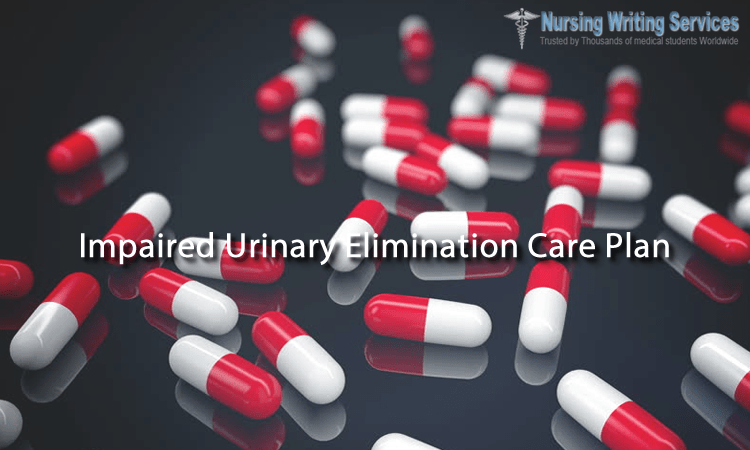
Impaired urinary elimination is a dysfunction in urinary elimination. You can also define it as a disturbance to a pattern of urine elimination. It a general diagnosis for clinical use and is very helpful for the gathering of further data that a nurse views to determine the precise infection such as stress urinary incontinence. Impaired Urinary Elimination Care Plan documents all the details to the identification, assessment, treatment, diagnosis, and monitoring of impaired urinary elimination. It is usually a good idea for the nursing care team to seek trusted Impaired Urinary Elimination care plan writing help for the leads on writing quality nursing care plans for consistent follow up for their patients.
Impaired Urinary Elimination Care Plan Diagnosis
A care plan should show the way of identifying the presence of impaired urinary elimination. It is shown by one or more of these signs and symptoms.
- Incontinence
- Bladder distention
- Dribbling
- Enuresis
- Dysuria
- Hesitancy
- Retention of urine (large residual volumes)
- Dribbling
- Urgency to urinate
Impaired Urinary Elimination Care Plan Goals and outcomes
When a nurse prepares a care plan specifically for patients with impaired urinary infection, it should be a guideline to help them in achieving the following goals:
- Urinate smoothly and without bladder distention
- Urinate without retention
- Attain urine residues of less than 50 ml without overflow
- Identify cause of incontinence
- Understand the condition
- Develop techniques and behavior to prevent retention of urine/urinary infection
- Maintains clear urine without odor
- Overcomes /avert urine leakage
Impaired Urinary Elimination Care Plan Assessment
It is necessary that a care plan to focus on patient assessment to determine if the impaired urinary elimination is a response to chronic neural, genitourinary or acute condition. A caregiver can get a clue of the cause through these assessments.
Assessing urine frequency and amount (voiding pattern): By comparing the fluid intake and urine output, a nurse identifies the effectiveness of the renal bladder function. Emptying and fluid balance.
Note reports of urgency, incontinence, urinary frequency force and size of stream: All these observations show a degree of interference with urine elimination. Fullness over bladder following a void shows retention or inadequacy to empty thus a sign of bladder infection that requires intervention.
Review of the drug regimen: some medicines including OTC and recreational drugs like cannabis can affect bladder emptying.
Assess the nature of toileting facilities: Some patients may have mobility issues that interfere with access to the washroom and might require a bedside commode.
Assess the usual urination and incontinence pattern: many patients will only have difficulties in elimination urine in the morning after waking up due to storage of large volume in the bladder at night.
Impaired Urinary Elimination Care Plan Interventions
Bladder retraining when appropriate and according to the protocol
The type and timing of bladder program depend on the type of injury. A caregiver can train the patient to take fluid and urinate at certain hours. Digital stimulation of the trigger area, contraction of the abdominal muscles and credit maneuver are some of the ways to train a patient.
Encourage the patient to take adequate amount of fluid (2-4 liters per day)
Sufficient hydration promotes output of urine and infection. Patient on sulfa drugs requires many fluids to sustain excretion and reduce the risk of cumulative effect. All patients should avoid caffeine and aspartame, a sugar substitute that can cause bladder irritation and subsequent bladder dysfunction. A caregiver should recommend the use of juice containing cranberry/ Vitamin C and limit intake in late evenings and bedtime.
Administer medication according to prescription
Physicians recommend the patient to take drugs that reduce bladders spasticity. A caregiver should ensure that the patient takes them according to directions to treat problems of urgency, frequency, nocturia or incontinence.
Catheterize when and as indicated
Catheterization can at times be necessary for evaluation or treatment when a patient retains urine or unable to empty the bladder.
The caregiver also has a role in training self-catheterization to promote self-care and autonomy.
Other interventions
The caregiver also has a role in training self-catheterization to promote self-care and autonomy.
- Check urine for foul odor, cloudy or bloody appearance.
- Help to clean perineal area, maintain dryness and provide catheter care.
- Promote continued mobility
- Teach kegel exercises to improve tone of the pelvic floor muscle and ureterovesical junction
- Recommend good washing of hands and perineal hygiene to decrease the risk of skin irritation, breakdown and developing of ascending infection.
A caregiver serving a patient who takes alcohol and caffeine should informant the person about the dangers of these substances in increasing over activity and causing bladder irritation.
Impaired Urinary Elimination Care Plan Writing Help
Coming up with a clear nursing care plan may be a bit challenging for the nurse on duty. For this reason, most of the nurses seek Impaired Urinary Elimination Care Plan writing help online for a good and detailed care plan. We offer exclusive Nursing Care Plans Writing Services to nurses and nursing students at affordable rates. Our Nursing care plans are original, structural and well-written to provide an easy guide to assessment and treatment for patients. Hire our competent writers for an affordable Impaired Urinary Elimination Care Plan writing help online with 100% money guarantee.

